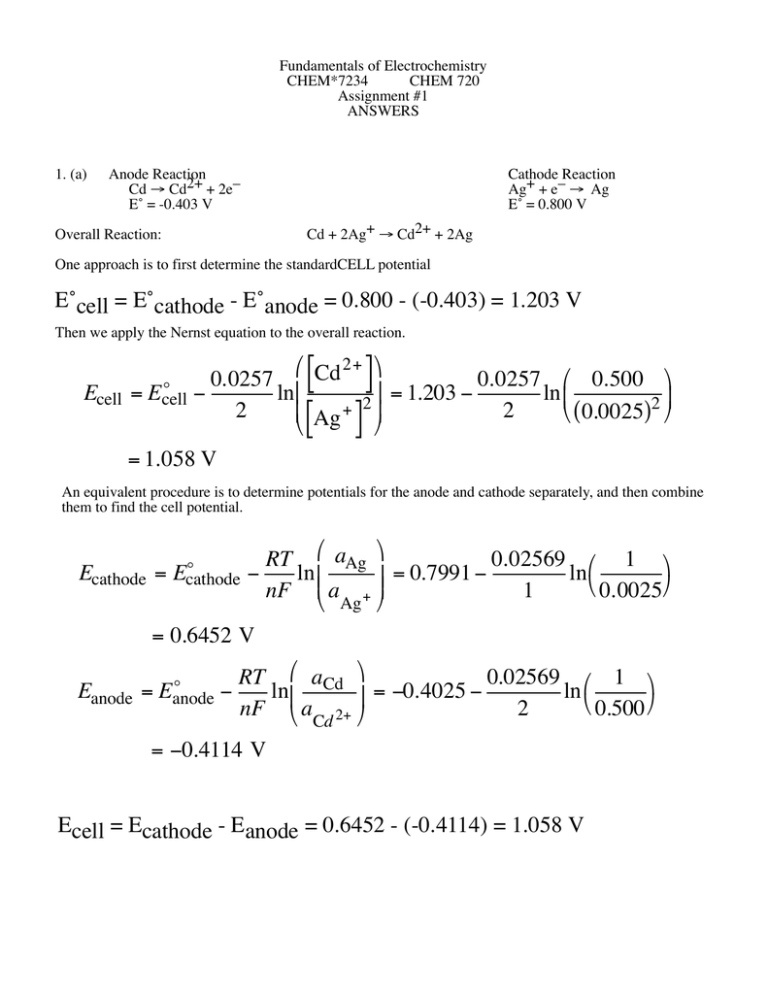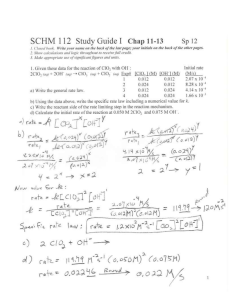E˚cell = E˚cathode - E˚anode = 0.800 - (-0.403) = 1.203 V
advertisement

Fundamentals of Electrochemistry CHEM*7234 CHEM 720 Assignment #1 ANSWERS 1. (a) Anode Reaction Cd Æ Cd2+ + 2e– E˚ = -0.403 V Cathode Reaction Ag+ + e– Æ Ag E˚ = 0.800 V Cd + 2Ag+ Æ Cd2+ + 2Ag Overall Reaction: One approach is to first determine the standardCELL potential E˚cell = E˚cathode - E˚anode = 0.800 - (-0.403) = 1.203 V Then we apply the Nernst equation to the overall reaction. Ecell [ ] [ ] Ê Cd 2+ ˆ 0.0257 0.0257 Ê 0.500 ˆ o ˜ = Ecell lnÁ = 1.203 ln Á ˜ 2 + 2 Á Ag ˜ 2 Ë ( 0.0025)2 ¯ Ë ¯ = 1.058 V An equivalent procedure is to determine potentials for the anode and cathode separately, and then combine them to find the cell potential. Ecathode = o Ecathode RT Ê aAg ˆ 0.02569 Ê 1 ˆ ln Á = 0.7991 ln ˜˜ Ë 0.0025¯ Á nF Ë a + ¯ 1 Ag = 0.6452 V o Eanode = Eanode RT Ê aCd ˆ 0.02569 Ê 1 ˆ lnÁ = -0.4025 ln ˜ Ë 0.500 ¯ nF Ë aCd 2+ ¯ 2 = -0.4114 V Ecell = Ecathode - Eanode = 0.6452 - (-0.4114) = 1.058 V (b) As we have only been given the standard cell potential at this temperature, we only have the option of applying the Nernst Equation to the complete cell reaction and obtain Ecell [ ] [ ] Ê Cd2+ ˆ (8.314 )(323) Ê 0.500 ˆ RT o ˜ = Ecell lnÁ = 1.177 lnÁ ˜ 2F Á Ag+ 2 ˜ 2(96485.31) Ë ( 0.0025)2 ¯ Ë ¯ = 1.020 V 2. By following the lead of the given paper, you should have been able to develop the ideas for this specific situation. Cu(s1) Ag(s ) AgBr(s ) KBr, H 2O Hg(l ) Cu(s2 ) This is the specific cell. The copper on each end is meant to represent the copper wires inside the potential measuring instrument. This is, of course, the place where the potential difference is actually measured. From an electrochemical point of view, the cell consists of a silver-silver bromide reference electrode at the anode and a mercury electrode at the cathode. An aqueous solution of KBr is the electrolyte. We start with the Gibbs adsorption isotherm for the metal-solution interface. charged species uncharged species -dg =  Gi dmi +  Gi dm i i i This indicates that changes in the surface energy arise from changes in the chemical potential of the various charged(using electrochemical potential) and uncharged species (using chemical potential), according to their Gibbs excess. We now write out this expression for the specific instance of this cell. We need to remember that we must also treat the electrons in the electrode explicitly too. -dg = G Hg + +G dm Br - Hg + dm Now, by arguments of equilibrium we can develop a relationship between the electrochemical potential of electrons in the copper wire and the electrochemical potential of ions at the interface. Here is the development for Hg+ ions. +G e- Br - m dm e- +G K+ dm K+ + GH 2O dm H 2 O (Hg ) e- Cu (s2 ) ) ( =m e- mHg = m Hg + + m m Hg + ( Hg) e- = m Hg - m = m Hg + + m (Cu(s2 ) ) e- (Cu( s2) ) e- 2 The electrochemical potential of electrons in two metals are the same when the two metals are in contact with each other and the system is at equilibrium. m (Hg ) =m e- 3 (Cu(s2 ) ) e- Here is the relationship between the chemical potential of an uncharged species and the electrochemical potential of its ion and electron arising from the ionization. mHg = m Hg + Hg + m(- ) = m e m Hg + = m Hg - m Hg+ +m (Cu(s2 ) ) e- ( Cu(s2) ) e- With these expressions we can rewrite the first two terms in the main equation. G Hg + dm Hg+ + G - dm e = GHg+ dm Hg - GHg + =G (Cu(s2 ) ) = G È ( Cu( s2) ) ˘ + G dm (Cu( s2) ) d m m ˙ e- eHg + Í Hg e Î ˚ e- Cu ( s2) ) ( dm +G e- e- Cu (s2) ) ( dm e- (Cu( s2) ) ˆ dm Hg + ¯ e- Ê + dm Hg + Ë G - - G Hg e The charge density on the electrode is related to the difference in Gibbs excess at the interface (F relates coulombs and moles) s M = FÊË GHg + - Ge - ˆ¯ \- sM = Ge - - GHg + F We substitute into the above expression and we observe that the chemical potential of elemental mercury is fixed and constant. Hence, its differential is 0. Therefore dm Hg = 0 G Hg + dm Hg + + G - dm e (Cu(s2 ) ) = - s M dm (Cu(s2 ) ) e - F e - We now look at the next two terms in the original expression. First we note a fundamental relationship between a molecule and its ions. mKBr = m K+ \ m +m K+ Br - = m KBr - m Br - Now, because there must be equilibrium at the reference electrode interface, where the reaction AgBr(s) + e– Æ Ag(s) + Br– is occuring, then this implies the following relationship: mAgBr + m (Cu(s1) ) = m e- Ag +m Br - And since d m AgBr = d m Ag = 0 dm (Cu(s1) ) = d m e- Br - This allows us to write the following: dm G K+ =G K+ =G K+ dm +G K+ Br - dmKBr - G K+ ( Br dmKBr + G Br - dm K+ Br - +G Br - -G K+ - [ d m KBr - m =G Br - dm ]+ G Br - dm Br - Br - Cu ( s1) ) ( dm ) e- Since the interfacial charge density arises from this difference in Gibbs excess, we have ( Br sM = F G G K + dm K - + -G K+ +G Br ) - dm Br - =G K + dm KBr + s M (Cu (s1) ) dm e F So our original expression now takes on the form s M (Cu ( s2) ) s M ( Cu( s1) ) -dg = dm + G + dm KBr + dm + GH 2O dm H 2 O K e e F F = s M È (Cu (s1) ) (Cu(s2 ) ) ˘ + G dm + G dm dm dm KBr H2O H2 O ˙ K+ eF ÍÎ e ˚ Since we can assume that the two copper wires have the same composition, their electrochemical potential differences is just the potential difference between the two wires. This means dm (Cu( s1) ) - dm (Cu(s2 ) ) = F dE e- e- -dg = s M dE + GK + dmKBr + GH 2 O dm H 2 O 4 5 We now call in the Gibbs-Duhem equation. We do this because the chemical potential of the water and the KBr as linked. You can’t change one without changing the other; you increase KBr concentration only by decreasing H2O concentration. We obtain X KBr dm KBr + XH 2 O dm H 2 O = 0 dm H 2O = - XKBr dmKBr XH 2 O Hence, we can rewrite the equation in the final form we seek. Ê ˆ X -dg = s M dE + Á GK + - KBr GH 2 O ˜ dmKBr XH 2 O Ë ¯ 3 (a) The charge density on the metal is balanced by the charges brought to the interface by the anions and cations. The charge, Z, on each species must be correctly accounted for, along with the fact that the excess electrode charge density is of electrons (negatively charged). With two values we can calculate the third. 2 sM (µC/cm ) -20 -18 -16 -14 -12 -10 -8 -6 -4 -2 0 2 4 6 8 10 12 14 16 18 2 ZFGK+ (µC/cm ) 18.31 16.33 14.34 12.36 10.43 8.77 7.86 7.8 8.19 8.75 9.4 10.04 10.67 11.27 11.84 12.43 12.95 13.43 13.88 14.29 2 ZFGI- (µC/cm ) 1.69 1.67 1.66 1.64 1.57 1.23 0.14 -1.8 -4.19 -6.75 -9.4 -12.04 -14.67 -17.27 -19.84 -22.43 -24.95 -27.43 -29.88 -32.29 -s M = z F G K+ +zFG I- z F GI - = -s M - F GK + Using this we can calculate the Gibbs excess charge density for the iodide ions. The data is given in the table below and the K and I Gibbs excess are graphed in the accompanying figure. In the indicated region of the graph, the iodide ion is super-equivalent. If you calculate the slope of the curve in this region, you will find it to be about 1.27. This means that when there is change in the electrode charge density, there is a 27% greater change in the iodide Gibbs excess. There is a greater-than-equivalent change in the iodide Gibbs excess. Hence, it is superequivalent. This points to the fact that the iodide is being specifically adsorbed on the electrode at these potentials. A similar examination of the potassium Gibbs excess at positive potentials will show that it is NOT specifically adsorbed. 6 3(b). The differential capacity is determined by finding the derivative of the E vs charge density curve at every point. We can approximate this derivative by taking differences. We do this and assign the capacity to the mid-point of the of the two potential values used in each calculation. This is quite easily done with a spreadsheet program. The results for the three sets of data are given in the table below and graphed on the accompanying curve. The pzc is at the minimum of the low concentration differential capacity curve: about -0.5 V. The double layer capacitance, CDL, is related to the capacitance of the Helmholtz layer, CH, and that of the diffuse layer, CD, as the sum of reciprocals. Away from the pzc, the diffuse layer capacity is largest and the overall capacity is controlled by that of the Helmholtz layer. However, in dilute solutions, the diffuse layer capacitance drops considerably near the pzc so that the double layer capacitance is now determined by it. This is the cause of the dip in the differential capacity curve and why it only happens in dilute solutions. 1 1 1 = + CDL CH CD 7 E(V) C(0.916) C(0.100) C(0.0010) -1.8 21 20.3 18.2 -1.7 19.6 18.9 17.2 -1.6 18.7 18 16.3 -1.5 17.7 17.2 15.8 -1.4 17 16.6 15.3 -1.3 16.6 16 15 -1.2 16.2 15.8 14.8 -1.1 16 15.8 14.9 -1 16.2 16.2 15.3 -0.9 17 16.8 15.9 -0.8 18.4 17.9 16.3 -0.7 20.2 19.2 16.1 -0.6 22.5 19.9 12.5 -0.5 25.1 20.5 6.8 -0.4 26.9 21.9 9.1 -0.3 27.8 24 16.5 -0.2 28.1 25.8 21.6 -0.1 29 26.5 23.8 0 31.2 28.7 24.6 0.1 52.9 30.2 26 0.2 29.1 [NaF] = 0.916 M [NaF] = 0.100 M [NaF] = 0.0010 M


